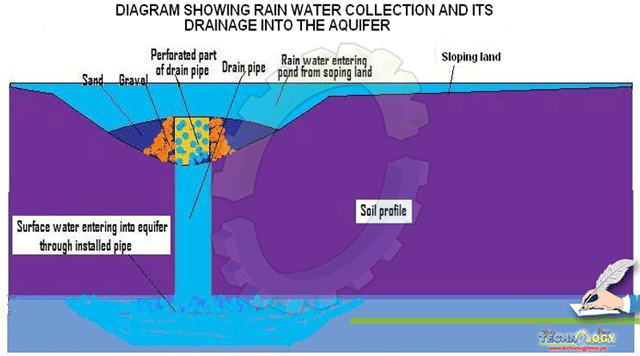The safest way to fight flood situation in big cities after heavy rains?

By Dr. Fahad and Dr. Rashid A. Khan
In Cholistan, availability of drinking water for animals and human beings is hardly available necessity through out the year which ultimately resists sustainability of livestock production. Underground water is brackish thus unfit for drinking purpose. Similarly, harsh environmental conditions are also unfavorable in this connection. Under the circumstances, limited amount of water received through erratic rains need to be saved and properly utilized. In the past, billions of rupees have been spent on supplying and conserving water sources (underground water ponds, shaded water ponds) in the area with minor success. During current study under HEC funded research project many successful experiments have been completed and further research is in progress on this issue to achieve the best success on water conservation in practical terms.
In this newly tested technology for water conservation in reservoirs (Tobas), a thin polyethylene sheet is spread on water surface which cut down surface evaporation and enhances time of water retention. Animal are allowed to drink in a corner of the water pond where polyethylene sheet is timely folded back. Fortunately, due to hard clay soil base, chances of seepage are very low in the local Tobas of Cholistan. Only the prevailing high temperature during summer months accelerates evaporation rate and contributes heavy losses to ponded water. Studies have indicated that this technique is highly effective for water conservation in reservoirs for a longer time depending upon quantity of water received through rains. Cost of spreading polyethylene sheet on the water surface of one acre big Toba has been estimated from 12 to 15 thousands rupees which can efficiently works for 2 to 3 years. This polyethylene sheet also cut down air connection with water thus reduces its oxygen content which helps in minimizing production of many living entities like tadpoles, leaches, mosquitoes etc. in water and keeps it useable for days to come. Studies are going on to make this technique more successful and sustainable. Research paper has been written on the achievements of this technology to be published to familiarize this technique in water stressed areas.
Another innovative idea of recharging the aquifer using rain water has been successfully applied for water conservation at few sites in Cholistan. This is simple and a very useful technique. Locally, Dahars (hard-clay mud flats) are the best sources for water collection during rainy season. This is why all Tobas have been built at their sloping ends in the area. According to this new technology, instead of making above ground water reservoirs, the collected rain water from Dahars is drained into underground sand layers or aquifer and pumped out when required for domestic uses.
This technique could be highly useful for recharging aquifer anywhere else. In the modern age, there is shortage of canal water therefore underground water is heavy exploited for irrigation purpose as well as for domestic uses. Ultimately, the source is quickly depleting. If similar speed of water use continued, it can totally drain out the local aquifers especially in and around big cities. This has already happened in many thickly populated areas where ordinary pumps are being replaced with deep installed turbine pumps to continue water supply.
The said technology can be best utilized for recharging underground water sources in cities, farmlands, deserts or anywhere else. During heavy rains, low lying areas of Lahore, Karachi and Faisalabad frequently sink in rain water and do enormous losses. By using this technique, collected sweet rain water can be safely drained into deeper underground layers or aquifer. This will not only do good for improving underground water table of the area but will also help to fight flood situation during erratic heavy rains or rainy season.
In this technique, a pipe (diameters based on discharge of the area) is permanently installed vertically in a reasonable sized pit at the deepest point of the area where rain water frequently gets collected. This pipe will help to drain the collected water into the aquifer. The upper end of this pipe is kept at least three-four feet above the ground level of the pit dug for rain water collection (See Fig 1).

Figure 1: Schematic diagram showing various installations of the Aquifer Recharging Technique by using rain water.
Many holes are made in the above ground portion of this pipe before installation while its top is permanently closed. All the side-holes of this pipe are covered first with gravel layers, then with course sand and lastly with fine sand layers to act as water filter (see Fig 1). Now during rainy season, water will rush toward sloppy area and instead of standing there it will start entering the drain pipe already installed to dispose off this water into the aquifer. The gravel and sand layers covering the above ground portion of this fixed pipe will help to filter rain water before entering the pipe and will avoid its choking. This is simpler technology which itself guide the user where to install necessary drain pipe and how it will rescue the area form flooding during rainy season.
The way we are lavishly using ground water for agriculture, industry and for domestic uses, this technique of recharging aquifer is not only highly useful but becoming inevitable with the passage of time. For further information, please contact Dr. Fahad and Dr. Rashid Ahmad Khan, Department of Forestry, University of Agriculture Faisalabad.
*Assistant Professor ** Prof./Subject Expert
Department of Forestry and Range Mgt.,
Faculty of Agriculture,
University of Agriculture,
Faisalabad

Authors: Dr. Fahad and Dr. Rashid A. Khan